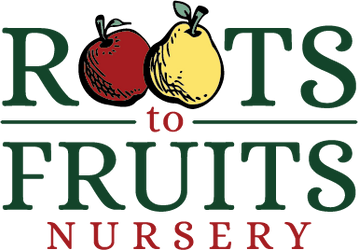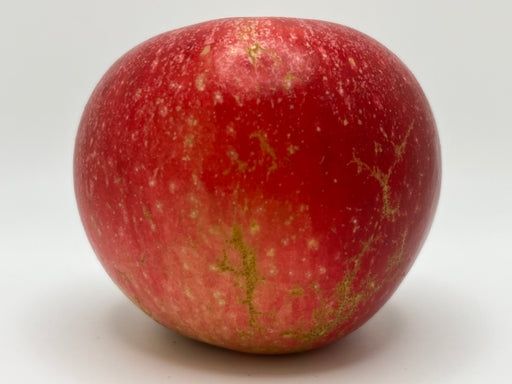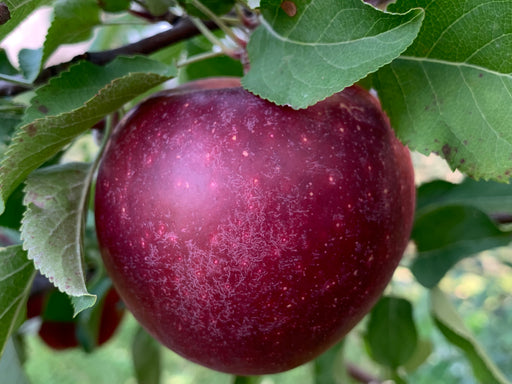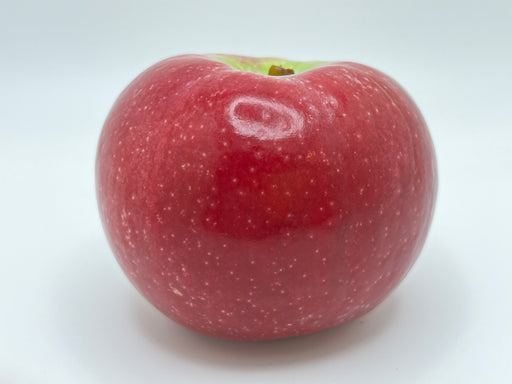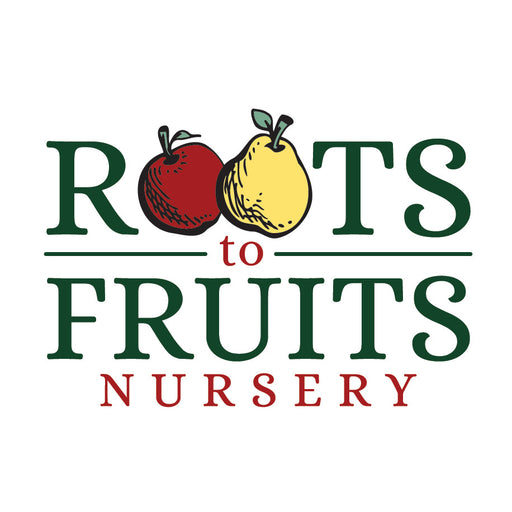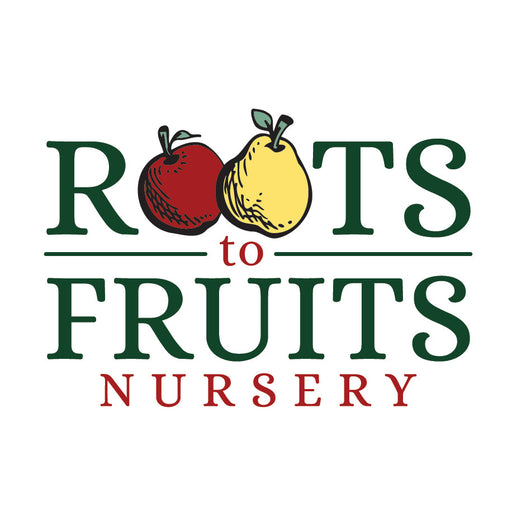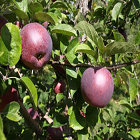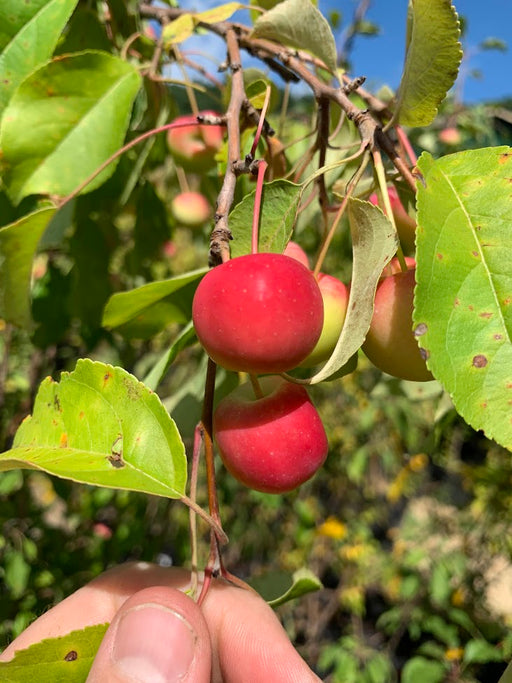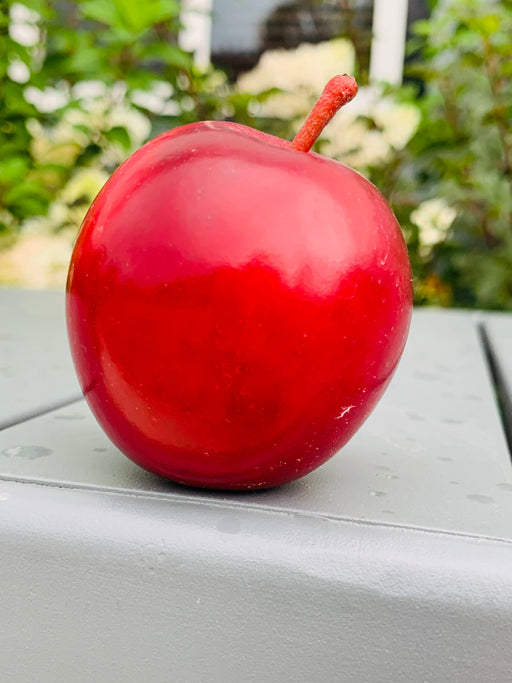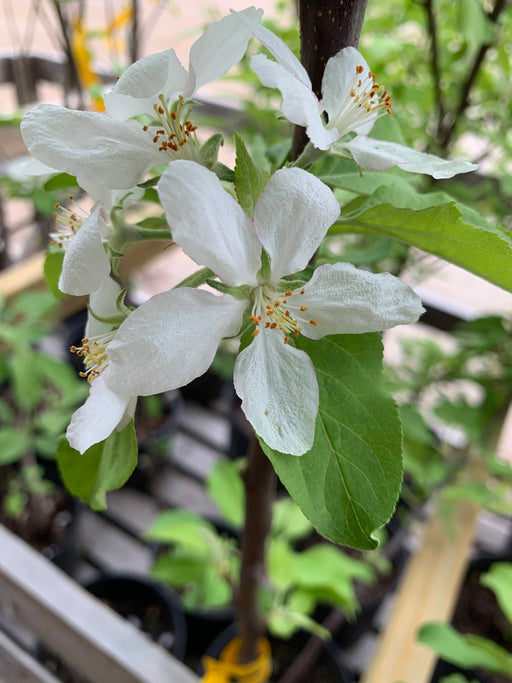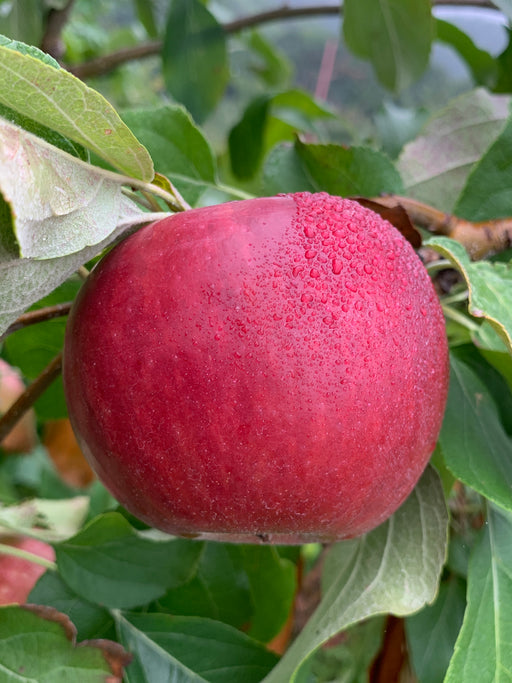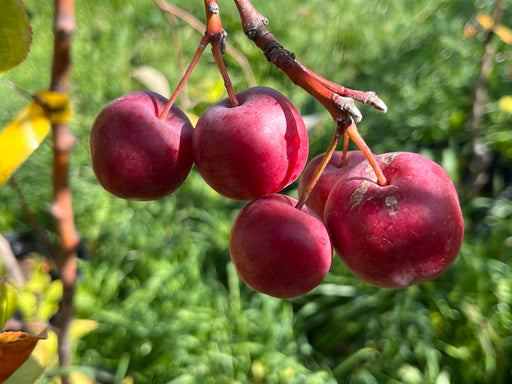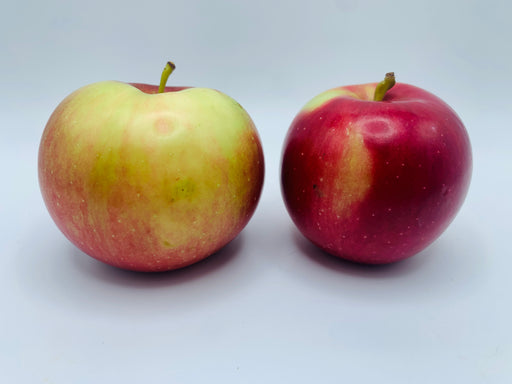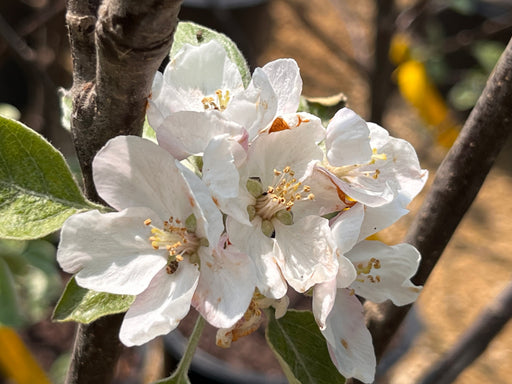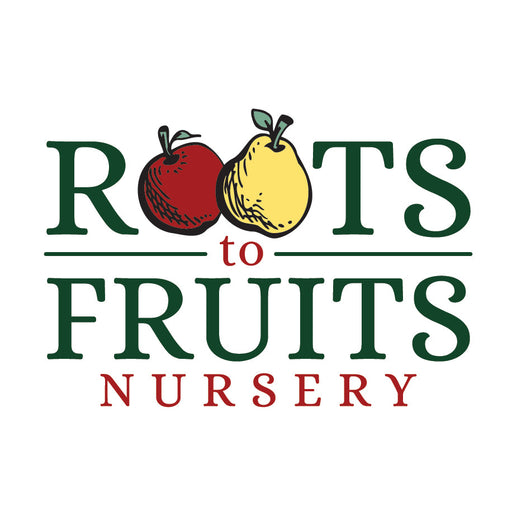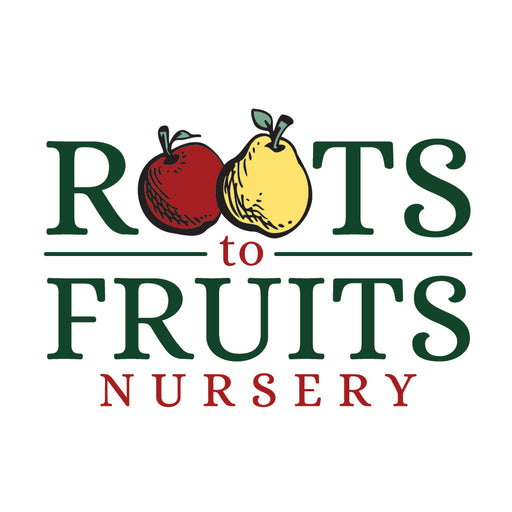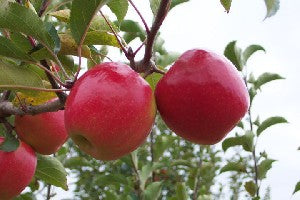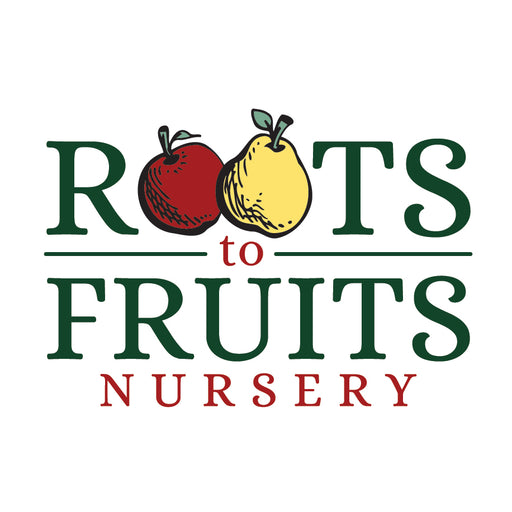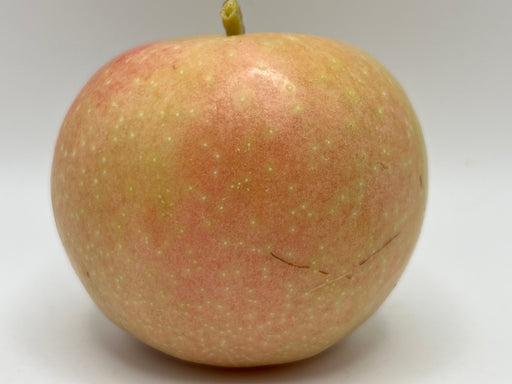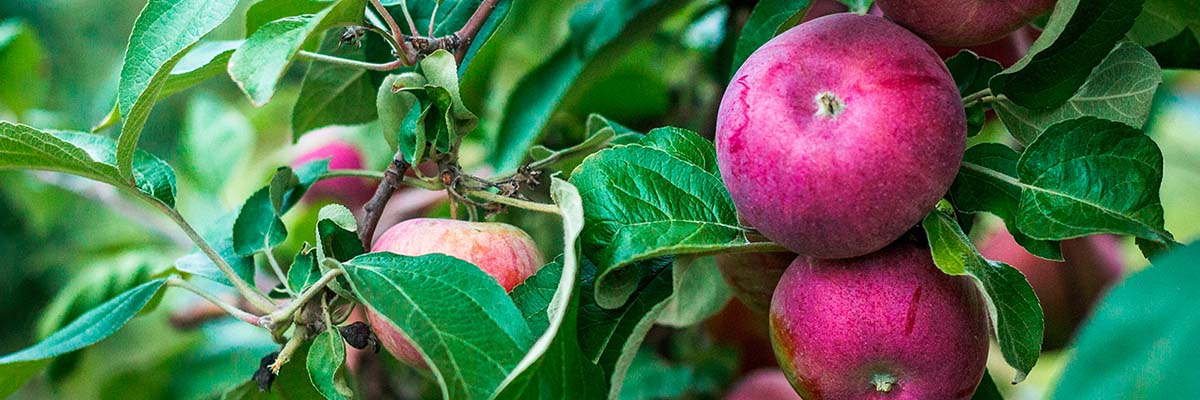
Apple Trees
Our apple trees, like many fruit trees, are propagated by grafting. There are 2 parts to an apple tree. A Scion, which is the fruiting part of the tree, gives you the variety of apple, and the Rootstock, which influences the mature size of the tree and hardiness of the tree, determines the time it takes for the tree to fruit. We sell Standard, Semi-dwarf, Dwarf and Mini-dwarf trees that do not re quire a lot of space but will bear large fruit.
- Trees must be planted in well drained soil
- 6 hours of sunlight Full sun preferred
- Stake all trees for the first 2 years. Dwarfs must have permanent stakes
- Tree guards should be used
- Plant at least 2 Different apples trees for Cross Pollination
- Plant disease resistant trees for less maintenance
We categorize our apple trees into four sizes: Maiden, Field Ready, Hand Select, and (3 or 5) Gallon Container depending on the size of the tree. Maiden trees are usually 2 years old and are branchless. These are also called whips and will bear in 2-3 years. A Field Ready tree is 2-3 years old and might have some lateral branching, be thicker above the graft, and will bear in 1-2 years. The Hand Select trees are only about 20% of trees we have and are 3 year old trees, 6-9' tall and are heavily branched. You can expect fruiting on a Hand Select tree in about a year.
-
Original price $33.00 - Original price $99.00Original price$33.00 - $99.00$33.00 - $99.00Current price $33.00| /
Jonathan Apple
Low stockThe Jonathan apple is a seedling of the Esopus Spitzenburg discovered in 1826 on Philip Ricks' farm in Woodstock, NY. A different person, Jonathan...
View full detailsOriginal price $33.00 - Original price $99.00Original price$33.00 - $99.00$33.00 - $99.00Current price $33.00| / -
Original price $33.00 - Original price $79.00Original price$33.00 - $79.00$33.00 - $79.00Current price $33.00| /
Keepsake Apple
In stockThe newly redefined parent of the famous Honeycrisp. Firm apple with a satisfying crunch. Light yellow flesh that is sweet and juicy. Good storer a...
View full detailsOriginal price $33.00 - Original price $79.00Original price$33.00 - $79.00$33.00 - $79.00Current price $33.00| / -
Original price $33.00 - Original price $99.00Original price$33.00 - $99.00$33.00 - $99.00Current price $33.00| /
Kickapoo Spice Apple
In stockDeveloped in Gays Mills, WI at the Orchard of Bill and Marlene Meyer. A spicy apple that takes advantage of the Driftless Region's unusual topograp...
View full detailsOriginal price $33.00 - Original price $99.00Original price$33.00 - $99.00$33.00 - $99.00Current price $33.00| / -
Original price $33.00 - Original price $59.00Original price$33.00 - $59.00$33.00 - $59.00Current price $33.00| /
King David Apple
In stockDiscovered by chance in an orchard in Washington County, Arkansas in 1893, the King David Apple is probably an offspring of Jonathan and Arkansas B...
View full detailsOriginal price $33.00 - Original price $59.00Original price$33.00 - $59.00$33.00 - $59.00Current price $33.00| / -
Original price $33.00 - Original price $59.00Original price$33.00 - $59.00$33.00 - $59.00Current price $33.00| /
Liberty Apple
In stockDeveloped in 1955 at the NYSAES as an offspring of the Macoun and Purdue 54-12 (a Japanese flowering crabapple) to create an extremely disease res...
View full detailsOriginal price $33.00 - Original price $59.00Original price$33.00 - $59.00$33.00 - $59.00Current price $33.00| / -
Original price $22.00 - Original price $107.00Original price$22.00 - $107.00$22.00 - $107.00Current price $22.00| /
M.27 Rootstock
In stockA very dwarfing rootstock~ smaller than M.9 or B.9. Needs central leader support of tree will be very small. Typically drafted with other rootstock...
View full detailsOriginal price $22.00 - Original price $107.00Original price$22.00 - $107.00$22.00 - $107.00Current price $22.00| / -
Original price $21.00 - Original price $103.00Original price$21.00 - $103.00$21.00 - $103.00Current price $21.00| /
M.7 Rootstock
In stockAlso known as EMLA 7, this rootstock hails from 1912 at the East Mauling Research Station and probably the most common semi-dwarf rootstocks. It pr...
View full detailsOriginal price $21.00 - Original price $103.00Original price$21.00 - $103.00$21.00 - $103.00Current price $21.00| / -
Original price $33.00 - Original price $99.00Original price$33.00 - $99.00$33.00 - $99.00Current price $33.00| /
Macoun Apple
Low stockIntroduced by the NYSAES in 1923, the Macoun is a cross of McIntosh and Jersey Black. It is named after Canadian horticulturalist W.T. Macoun but w...
View full detailsOriginal price $33.00 - Original price $99.00Original price$33.00 - $99.00$33.00 - $99.00Current price $33.00| / -
Original price $33.00 - Original price $59.00Original price$33.00 - $59.00$33.00 - $59.00Current price $33.00| /
Manchurian Crab
Low stockManchurian Crabapple is a native of northern Asia. It is now grown worldwide as an ornamental and is often employed as an apple tree pollinator. It...
View full detailsOriginal price $33.00 - Original price $59.00Original price$33.00 - $59.00$33.00 - $59.00Current price $33.00| / -
Original price $20.00 - Original price $99.00Original price$20.00 - $99.00$20.00 - $99.00Current price $20.00| /
McIntosh Apple
Low stockOne of the most popular apples in the world today, the McIntosh (sometimes spelled Macintosh) apple gained its roots back in 1811 at a farm in 'Up...
View full detailsOriginal price $20.00 - Original price $99.00Original price$20.00 - $99.00$20.00 - $99.00Current price $20.00| / -
Original price $33.00 - Original price $59.00Original price$33.00 - $59.00$33.00 - $59.00Current price $33.00| /
Melrose Apple
Low stockDeveloped by Freeman Howlett at the Ohio AES in 1944, the Melrose apple is the official state apple of Ohio. Its late harvest time makes this a go...
View full detailsOriginal price $33.00 - Original price $59.00Original price$33.00 - $59.00$33.00 - $59.00Current price $33.00| / -
Original price $33.00 - Original price $59.00Original price$33.00 - $59.00$33.00 - $59.00Current price $33.00| /
Michelin Apple
Low stockThis French cider apple was first propagated in 1872 in Yvetot, Normandy and is named for pomologist Henri Michelin. The apple tree is actually no...
View full detailsOriginal price $33.00 - Original price $59.00Original price$33.00 - $59.00$33.00 - $59.00Current price $33.00| / -
Original price $33.00 - Original price $49.00Original price$33.00 - $49.00$33.00 - $49.00Current price $33.00| /
Monarch Apple
In stockAn old English (Essex) variety bred in 1888 by crossing a Peasgood's Nonsuch (probably the coolest apple name ever) with a Dumelow's Seedling and ...
View full detailsOriginal price $33.00 - Original price $49.00Original price$33.00 - $49.00$33.00 - $49.00Current price $33.00| / -
Original price $33.00 - Original price $59.00Original price$33.00 - $59.00$33.00 - $59.00Current price $33.00| /
Mont Blanc Crabapple
Low stockA prolific bloomer, the Mont Blanc Crabapple's bud is a bright pink in color that opens to a snow white flower after many other blooms have opened....
View full detailsOriginal price $33.00 - Original price $59.00Original price$33.00 - $59.00$33.00 - $59.00Current price $33.00| / -
Original price $99.00 - Original price $199.00Original price$99.00 - $199.00$99.00 - $199.00Current price $99.00| /
Multi-Grafted Trees
Low stockMost Apples, Pears, and Cherries require multiple trees to pollinate. For those with small yards or gardens- these multi-grafted trees are function...
View full detailsOriginal price $99.00 - Original price $199.00Original price$99.00 - $199.00$99.00 - $199.00Current price $99.00| / -
Original price $33.00 - Original price $59.00Original price$33.00 - $59.00$33.00 - $59.00Current price $33.00| /
Norland Apple
Low stockThe extremely cold hardy tree originated in 1980 by the Agriculture Canada Research Station in Manitoba, Canada, the Norland Apple is a cross betwe...
View full detailsOriginal price $33.00 - Original price $59.00Original price$33.00 - $59.00$33.00 - $59.00Current price $33.00| / -
Original price $33.00 - Original price $99.00Original price$33.00 - $99.00$33.00 - $99.00Current price $33.00| /
Northern Spy Apple
Low stockOriginating in 1804 as a seedling on the farm of Herman Chapin in East Bloomfield, NY, the Northern Spy Apple almost did not survive. Attacked by ...
View full detailsOriginal price $33.00 - Original price $99.00Original price$33.00 - $99.00$33.00 - $99.00Current price $33.00| / -
Original price $33.00 - Original price $79.00Original price$33.00 - $79.00$33.00 - $79.00Current price $33.00| /
Northwest Greening Apple
In stockN.W. Greening is a Wisconsin Native! Jasen Hatch of Iola, WI crossed a Golden Russet with an Alexander in 1849- the seedlings of the new apple were...
View full detailsOriginal price $33.00 - Original price $79.00Original price$33.00 - $79.00$33.00 - $79.00Current price $33.00| / -
Original price $33.00 - Original price $59.00Original price$33.00 - $59.00$33.00 - $59.00Current price $33.00| /
Orange Winter Apple
In stockGrafted from trees at 1913 Kickapoo's Orchard~ this apple is cold hardy and makes a great pie. The apple is quite large, nearly 4" across and is ve...
View full detailsOriginal price $33.00 - Original price $59.00Original price$33.00 - $59.00$33.00 - $59.00Current price $33.00| / -
Original price $21.00 - Original price $104.00Original price$21.00 - $104.00$21.00 - $104.00Current price $21.00| /
Pajam 2 Rootstock
In stockVery similar to M.9 and its related families, the Pajam 2 Cepiland is a French rootstock know to be one of the strongest M9 grafts available today....
View full detailsOriginal price $21.00 - Original price $104.00Original price$21.00 - $104.00$21.00 - $104.00Current price $21.00| / -
Original price $33.00 - Original price $59.00Original price$33.00 - $59.00$33.00 - $59.00Current price $33.00| /
Pinata
In stockDescription Coming Soon! USDA Zone: Mature Height: MM106 ~16-17' or 70-75% of Standard Sun: Full Sun Bloom Group: Pollination: Required Harvest Dat...
View full detailsOriginal price $33.00 - Original price $59.00Original price$33.00 - $59.00$33.00 - $59.00Current price $33.00| / -
Original price $33.00 - Original price $59.00Original price$33.00 - $59.00$33.00 - $59.00Current price $33.00| /
Pink Lady Apple
In stockBred at the Department of Agriculture in Western Australia in 1970 by researcher John Cripps. He crossed the red Australian apple Lady Williams wit...
View full detailsOriginal price $33.00 - Original price $59.00Original price$33.00 - $59.00$33.00 - $59.00Current price $33.00| / -
Original price $33.00 - Original price $59.00Original price$33.00 - $59.00$33.00 - $59.00Current price $33.00| /
Pink Luster Apple
In stockThe Pink Luster is another Cornell University creation first debuted to the public in 2020. It is a large apple that is quite colorful. It has a ye...
View full detailsOriginal price $33.00 - Original price $59.00Original price$33.00 - $59.00$33.00 - $59.00Current price $33.00| / -
Original price $33.00 - Original price $59.00Original price$33.00 - $59.00$33.00 - $59.00Current price $33.00| /
Pink Pearl Apple
Low stockCreated in 1940 by Albert Etter after combing through seedlings from a 'Surprise' apple. He eventually settled on seedling #39- its properties wer...
View full detailsOriginal price $33.00 - Original price $59.00Original price$33.00 - $59.00$33.00 - $59.00Current price $33.00| /
